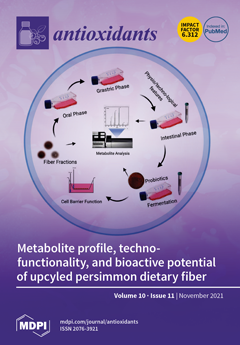The Maillard reaction (MR), or non-enzymatic browning, involves reducing sugars reacting with amino acids, peptides, or proteins when heated to produce an abundance of products that contribute to sensory, nutritional, and functional qualities of the food system. One example of an important functional
[...] Read more.
The Maillard reaction (MR), or non-enzymatic browning, involves reducing sugars reacting with amino acids, peptides, or proteins when heated to produce an abundance of products that contribute to sensory, nutritional, and functional qualities of the food system. One example of an important functional quality of MR relates to antioxidant capacity, which has relevance to preserve food quality and also to extend a potential role that may promote gastrointestinal health. The addition of Alphacel (10%), a non-reactive polysaccharide, to MR reactants produced small significant (
p < 0.05) reductions in yield of soluble Maillard reaction products (MRPs), sugar loss, and color change of products formed respectively, for reducing sugars. A similar effect was also noticed for different free-radical scavenging capacity (
p < 0.05), using chemical (e.g., 2,2-diphenyl-1-picrylhydrazyl (DPPH)), Trolox equivalent antioxidant capacity (TEAC), and oxygen radical absorbance capacity (ORAC) assays. An inflamed Caco-2 cell model revealed nitric oxide (NO) inhibitory activity for Glu-amino acid MRPs, which contrasted the NO stimulatory activity obtained with Fru-amino acid MRPs, especially when glycine was used as the amino acid. Pre-treating Caco-2 cells with Fru-glycine MRPs protected against loss in trans-epithelial resistance (TEER) (
p < 0.05) and reduced (
p < 0.05) disruption of Caco-2 intestinal epithelial tight-junction (TJ) protein cells when exposed to 7.5% ethanol. A low molecular weight Fru-glycine (e.g., <1 kDa) fraction contributed to the protective effect, not observed with the corresponding high molecular weight MRP fraction. The presence of Alphacel had minimal effect on generating MRPs with relative modified protection against intestinal dysfunction in cultured Caco-2 cells. Rather, different types of sugar–amino acid combinations used to generate MRPs contributed more to mitigate injury in stress-induced Caco-2 cells. With the growing evidence that MRPs have a wide range of bioactive activities, this study concludes that specificity of substrate precursors that produce MRPs in heated foods is a critical factor for antioxidant and related cellular functions that represent a healthy gut.
Full article






